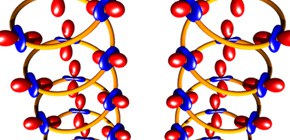
Successful observation of quadrupole helix chirality
Lead to the possible development of new long-term optical memory materials
A joint research group led by TANAKA Yoshikazu (Senior Research Scientist, Excitation Order Research Team, Quantum Order Research Group, SPring-8 Center, Riken) and KIMURA Tsuyoshi (Professor, Graduate School of Engineering Science, Osaka University) has succeeded in demonstrating chirality of quadrupole, helical configuration of an electric charge.
Atomic orbitals can describe the quantum states of electrons in the electron cloud around the atom. Atomic orbitals are not always globular, but deformed in some cases. This kind of distortion of atomic orbitals is called electric quadrupole. How a quadrupole is oriented in 3d transition metal compounds and 4f rare-earth metal compounds is important for electric, magnetic, and optical properties such as superconductivity and the phenomenon of huge magnetoresistance. Therefore, examining the status of a quadrupole gives a hint of its electric, magnetic, and optic properties.
By using resonant X-ray diffraction, this group measured quadrupoles and revealed the ferro-orbital ordering state and antiferro-ordering state occurring in certain kinds of 3d transition metal compounds and 4f rare-earth metal compounds.
This joint group advocated the concept of enantiomerism of electric quadrupole orientations whose verifications have been overlooked because of the difficulty of verification.
By making use of diffraction of circularly polarized soft X-rays using radiation light at the synchrotron radiation facility SPring-8, this group succeeded in visualizing symmetry breaking effects arising from chirality as well as observing the helix chiral domains. If the control enantiomorphic structure of quadrupole helix and its domain structure can be achieved by external pertubation such as circular polarization, it will lead to the possible development of new long-term optical memory materials.
Abstract
Resonant X-ray diffraction (RXD) uses X-rays in the vicinity of a specific atomic absorption edge and is a powerful technique for studying symmetry breaking by motifs of various multipole moments, such as electric monopoles (charge), magnetic dipoles (spin) and electric quadrupoles (orbital). Using circularly polarized X-rays, this technique has been developed to verify symmetry breaking effects arising from chirality, the asymmetry of an object upon its mirroring. Chirality plays a crucial role in the emergence of functionalities such as optical rotatory power and multiferroicity. Here we apply spatially resolved RXD to reveal the helix chirality of Dy 4f electric quadrupole orientations and its domain structure in DyFe 3 (BO 3 ) 4 , which shows a reversible phase transition into an enantiomorphic space-group pair. The present study provides evidence for a helix chiral motif of quadrupole moments developed in crystallographic helix chirality.

Figure 1

Figure 2

Figure 3
To learn more about this research, please read the full research report entitled " Observation of quadrupole helix chirality and its domain structure in DyFe3(BO3)4 " at this page of the Nature Materials website.
Related link :
